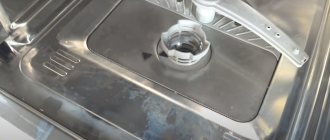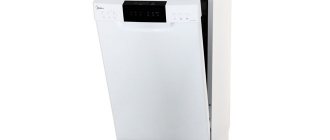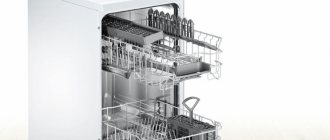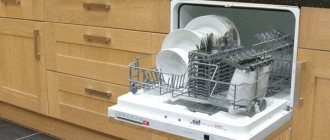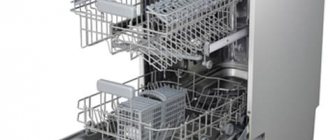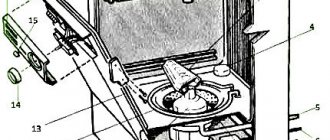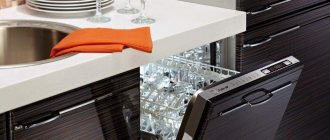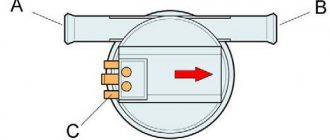Purpose of dishwasher salt
Regular tap water contains a lot of dissolved substances, including calcium and magnesium. As a result, when such water is used, especially if it is heated, limescale forms on various equipment components and deposits accumulate. Over time, this may cause the PMM to fail. To fix this problem, you have to pour salt into the dishwasher. Actually, the water is improved by a special resin located in the so-called ion exchanger. Gradually, this resin loses its properties, and a salt solution is necessary to restore the softening properties of the resin.
Typically, special salts are used for these purposes, which are available in the form of tablets or granules. As a rule, this component is poured in when the dishwasher is first started. In addition to increasing the service life of the machine, it improves the quality of washing dishes, especially in cases where utensils with dried stains and streaks that are difficult to wash are loaded into the PMM.
Often, to increase the efficiency of the dishwasher and its durability, an additional fine filter is installed, which purifies the water entering the machine.
Forms of release of regenerating agents
Manufacturers of various products used in dishwashers produce universal dishwashing tablets - “10 in one”, “7 in one”, etc. Some of them contain a small amount of special salt. However, this amount is not enough to maintain normal sodium levels in the ion exchanger. The solution in this situation is obvious - add additional professional salt.
Like dishwashing detergents, manufacturers offer special salt in a variety of forms:
- Powdered or granular regenerating agents.
- Salt compressed into tablets.
When choosing a specific product, you need to be guided by the composition that the manufacturer indicates on the packaging of the regenerating salt. A smaller amount of various impurities and additives in it will give the most effective result.
Selecting salt for PMM
Special dishwasher salt is suitable for use in any model, such as Whirlpool, Electrolux, Gorenje, Siemens, etc. This substance is available in two forms - in the form of granules and in the form of tablets. The granular form is more common, but both types are equivalent in their effectiveness; one does not have any advantages over the other. At the same time, granules are more convenient to fill, and tablets are easier to dose.
There are a large number of brands on the market under which both types of this component are produced. Popular brands of granular substances include Gut and Gunting, Finish, Kraft, Filtero, etc. The product in tablet form is sold under the brands Frau Schmidt, Dr.Prakti, Filtero, Topperr and some others.
For owners of Bosch dishwashers
Let us give examples from the instructions for the Bosch brand PMM, from which it is clear that it is necessary to use salt.
Hardness reducing device
In order for the washing to take place at the proper level, purified water, without calcium salts, must be supplied to the machine. Otherwise, scale will appear on the walls, dishes and parts of the machine. Water with high calcium hardness must undergo a purification procedure before reaching important parts of the device. To soften the water, a device built into the body of the machine is used; salt is poured into it.
Settings
It depends solely on the hardness of the water and not on any other indicators. To set up an ion exchanger, proceed as follows:
- Find out the hardness of your water supply.
- Use the hardness table provided to calculate the setting value.
- Turn the switch to 2.5.
In some models this is done as in the photo.
Using salt
When washing, the substance is automatically taken from the container and goes into a tank in which the softening process takes place. And the solution, which contains calcium salts, is drained into the sewer. Upon completion of the cleaning cycle, the system is again ready for further operation. Regeneration starts only when the salt is 100% dissolved.
Before starting the PMM, pour approximately 1 liter of water into the container for salt granules. For these purposes, use the funnel that comes with the device. Load the amount of granules that will raise the water level to the edge of the container (no more than 1.5 kg of substance). Since when loading the substance, water will pour over the edge, you need to load salt only just before turning on the device, otherwise such operation threatens rapid corrosion of the surfaces.
If during loading you spill the product a little, remove the spilled grains and close the container with a lid, making sure that there is no distortion.
By turning the ion exchanger regulator to o, you do not have to add salt, since water will bypass this device. With values ranging from “1” to “4” it is necessary to add salt.
Important! Do not pour powder into the special hopper or add gel or rinse aid - this will damage the device.
How to determine when it’s time to add salt to the PMM
Typically, PMMs are equipped with a salt indicator, which signals that it is time to put a new portion of this substance into the appropriate container. This indicator will glow constantly; to turn it off, pour the required salt solution there. The indicator can most often be identified by a pictogram of arrows intertwined in the shape of the letter S. In general, so that there is no doubt about this issue, it is better to study the dishwasher’s operating manual - there are descriptions of all the indicators and settings.
Our service center offers its services for repairing household appliances at a competitive price. We repair any breakdowns of modern household appliances. Leave a request and get a 15% discount - Leave a request
What to do if there is no indicator
Some models do not have an indicator. In this case, a signal that it is time to replenish the salt compartment is a decrease in the quality of dishwashing - a residue may remain on the utensils, which is especially noticeable on products made of transparent colorless glass. In such a situation, it is recommended to observe the dishwashing processes and determine the approximate time when a clear decline in quality begins. Then you just need to sprinkle the salt solution without waiting for a coating to appear on the dishes.
The most popular and sought-after brands of salts
- Our domestic manufacturer of various detergents, Finish, has long established itself for the quality and effectiveness of the products it produces. Thousands of customers who use the products of this brand respond only positively about its products. Including, there is also a salt solution for dishwashers from this manufacturer on the market. The product is enough for 25-30 dishwashing processes. The product is affordable and effective in use. Among the advantages are preventing the formation of scale on mechanisms and elements of equipment and softening the hardness of tap water. Due to the fact that salt foams well, there are no streaks or stains left on the dishes. A one and a half kilogram pack costs approximately 200-230 rubles.
- One of the most affordable and accessible brands of salt is “Magic Power”. Despite the rather low cost, salt performs its functions properly. In addition to salt, the manufacturer produces tablet rinse aids for dishwashers, detergents and salt with a softening effect. For proper and effective use of salt, the manufacturer recommends reading the instructions on the package. A pack of this product costs about 140 rubles.
- Another effective and efficient remedy is “Topperr”. It is available in the form of tablets or large crystals. The composition is selected in such a way that this salt helps soften the water, making the dishes very clean and shiny. For a one and a half kilogram pack or for 167 tablets you will pay about 450 rubles.
Do not underestimate the importance of sodium chloride for dishwashers, because its effect is truly priceless. It is thanks to this product that your dishwasher will serve you faithfully for many years, because salt rids the parts and mechanisms of equipment from the harmful effects of scale and impurities found in dirty tap water. In addition, it is salt that helps clean dishes from corrosive dirt, providing them with a beautiful shine and whiteness.
Today on the market of chemical detergents, there is a huge selection of different brands and manufacturers of specialized salts for dishwashers, so you can choose anything according to your wallet and your taste. You should not save on this product, because future repairs may cost you much more. It’s not for nothing that they say that the miser pays twice. Taking good care of your dishwasher is not that difficult, but it will repay you in full in the future.
How often do you put salt in the dishwasher?
If you have an appropriate indicator, it is very easy to determine how often to add salt to the dishwasher. As soon as this indicator lights up, you should immediately add dishwasher salt to the appropriate compartment, and it is advisable not to delay this procedure. If the device was used for the first time, this procedure may be necessary after 6-7 washes.
In the case where there is no indicator, the need to replenish the PMM ingredient will have to be determined experimentally, based on how well the dishes are washed. In general, how often you will have to add the component depends both on the frequency of use of the dishwasher and on the quality of the tap water.
How and when to fall asleep
It is recommended to add salt before turning on the Electrolux machine. Adding water will help the substance dissolve faster, which will help improve dishwashing. When using tablets, they should be placed in the detergent compartment, which is most often located on the inside of the door.
Salt is always loaded before turning on the machine - this is necessary to protect against corrosion.
How much product is poured into the container?
How much salt to pour for the first time, when you first start the dishwasher, is determined by the design of the machine and the rules prescribed in its operating instructions. Usually this is about one kilogram of the substance. In the future, as the need arises, the dishwasher is replenished with approximately the same amount of salt product.
What does salt contain?
Many people may think that dishwasher salt is almost the same as regular table salt, but this is not the case. First, dishwasher salt comes in larger granules. Secondly, such salt undergoes thorough purification, after which it simply cannot contain any impurities.
In addition, depending on the manufacturer, it can be made with the addition of the following components:
- Sodium citrate (serves to destroy germs and bacteria);
- Sodium percarbonate;
- Various flavoring agents;
- Sodium disilicate and bicarbonate;
- Sodium polyaspartate.
The above substances give the products of individual manufacturers distinctive properties. For example, some variations give water antibacterial properties or imbue it with a pleasant aroma.
Rules for adding salt
Before adding salt to the dishwasher for the first time, it is recommended that you familiarize yourself with some of the nuances of this procedure. When loading this substance, the following procedure should be followed.
- First you need to unscrew the lid of the corresponding container.
- Next, you need to pour about one liter of water into it (there will be no need to add water in the future).
- Then you need to pour granules or tablets into the neck of the container. It is convenient to use a funnel for this.
- At the final stage, wipe the neck of the filled container and surrounding areas from water and spilled substances, and then screw on the neck cap.
How to fall asleep
Manufacturers equip dishwashers with special large-diameter funnels. This device makes it easier to load salt and prevent crystals from scattering along the bottom of the working chamber. Experts advise that before pouring salt into Electrolux, Simens, Beko or other PMM for the first time, pour 1-1.5 liters of clean water into the compartment. As the bunker is filled with salt, excess liquid will flow down the drain, but crystals and granules will not stick to the walls of the ion exchanger. In the future, you will no longer have to do this, since the machine itself will take care of filling the compartment with water.
Where to add the salt solution before turning on the PMM
The location of the container where salt is poured in the dishwasher depends on the design of the PMM. Most often it is located under the compartment for dishes. In any case, the location of the container can be found in the dishwasher operating instructions. The container is equipped with a neck with a screw-on cap; it must be filled with saline solution. How to correctly fill this container with this component is described above.
When installing a dishwasher in the kitchen, it is extremely undesirable to install it next to the oven - usually such proximity leads to accelerated wear of the equipment. It is also recommended that there be at least a small air gap between the PMM and other household appliances.
Rating of brands and manufacturers
Almost every manufacturer of dishwashers also produces salt and detergent compositions for them, or recommends directly in the instructions for the machine to use a salt version of a particular brand with a specific dosage.
Prices for sold salt formulations vary little by brand - if saving money is not a priority, then it is best to purchase branded preparations recommended by the manufacturer of the dishwashing equipment in the kitchen
It is difficult to create a comprehensive rating of dishwasher salts, taking into account many different parameters. A similar composition is almost pure sodium chloride (usually the mass fraction of NaCl in them is 99.5–99.7%!). Inventing something special here is problematic.
According to the standards, the product in question should not contain additives, rinsing aids, impurities or detergents. If anything similar is included in the description of the composition, then this is not an active salt for the ion exchanger, but a regular dishwashing detergent in an automatic dishwasher such as “3 in 1”, “5 in 1”, “ALL in 1”, etc. . Such tablets and powders are placed in a completely different compartment in the dishwasher.
The best option for regenerating salt is large NaCl crystals. The finely ground powdered analogue is used up too quickly; it is better to avoid it in the store. You need to look for a salt product in the form of granules with a minimum size of 4–6 mm. Tablets are also good in this regard, but not every ion exchanger can contain them simultaneously in the required quantity.
1st place – Finish Calgonit
First place was given to Finish Calgonit due to the almost complete absence of negative reviews from housewives for products under this brand. In terms of cost, this salt is in the middle price segment.
Finish Calgonit is distinguished by high quality NaCl purification and large granules, whose characteristics are more consistent with premium products
This manufacturer also has products designed for washing dishes. We talked more about the brand's products in this material.
2nd place – Sodasan
Sodasan is as good as Finish Calgonite in sodium chloride purity, but costs a little more.
The salt consumption for the Somat PMM is a little higher, and in price it is practically not inferior to the first two competitors
We recommend: Cleaning collectible coins at home from blackness and green deposits
Final third place - Somat is a classic middling player.
In addition to salt, this manufacturer's product range includes highly effective tablet dishwashing detergents.
4th place – Eonite
Under the Eonit brand, there are two types of anti-scale salts on the market: regenerating NATURAL and CLEANVON.
The first product is positioned as made from natural raw materials, and the second – with 99.9% purification! But the naturalness of NaCl is a big question.
If the dishwasher is used frequently and a lot of dishes are washed, then this is a great option. However, if you use the dishwasher infrequently, it is better to take a cheaper anti-scale product
In all cases, you will have to pay about 100–250 rubles for a 1.5 kg pack of salt. The price depends on the region, the seller and discount promotions.
If a cheaper product is offered under a different brand with a cost below 100 rubles, then you should take it with caution. Cheapness here is the first sign of too small granules or low purity of sodium chloride. As a result, you will pay less for salt, but it will quickly be used up or cause damage to the washing machine.
The influence of water hardness on product consumption
Water quality directly affects salt consumption. The more calcium, magnesium and other substances dissolved in water, the higher its hardness and the more intense the consumption of saline solution to soften the water. Water hardness can be determined using special test strips. These test strips are usually purchased at pet stores or hardware stores. In addition, it is possible to order a water analysis at the SES or at any suitable laboratory - this guarantees an accurate result, but you will have to spend time and money.
Having determined the hardness level, you will need to configure the water softener (ion exchanger) in the PMM, setting the appropriate hardness value. Budget models or compact devices with limited functionality may not have this function. In this case, the effectiveness of using salt products may simply decrease, but the effect of their use itself will not disappear.
How water hardness level affects salt consumption
Here the relationship is direct: the harder the water, the more chlorine ions are needed to soften it in the ion exchanger. Therefore, before using your dishwasher, you need to find out how hard the tap water you are using is.
In Russia, the level of water hardness is measured in degrees (°Zh). One degree corresponds to a concentration of magnesium and calcium salts equal to 0.5 millimoles in a volume of liquid of 1 liter, or 1 mEq/l. It should be noted that water hardness is measured differently in different countries. For example, one Russian °Zh is equal to 2.8 German degrees (dH).
A schematic representation of the water cycle in nature shows at what stage magnesium and calcium salts enter the liquid
In different regions of Russia, water can vary greatly in the level of Mg and Ca compounds. It all depends on the soils in which the beds of streams, rivers and lakes are located. Water is divided according to its hardness level:
- for soft – the salt content does not exceed 3°F;
- for medium-hard – from 3 to 6°F;
- for hard – 6–10°F;
- for very hard – more than 10°F.
Hard liquid causes irreparable damage to both household appliances and plumbing systems. To calculate this indicator, you can use specially made test strips. You can buy them at any pharmacy. In some dishwasher models, such strips are included with the appliance.
Test strips for measuring water softness levels
Based on the test result and the recommendations of the instructions supplied with the equipment, it is necessary to set the sodium chloride consumption level to soften the liquid. For example, some models of Bosch dishwashers allow you to set up to 7 different values on the control panel, depending on the amount of Ca and Mg compounds in the liquid.
3-in-1 dishwashing tablets containing detergent, rinse aid and water softener
In conclusion, I would like to give advice to novice users: do not pay attention to advertising gimmicks or “7-in-1” used in PMM. They contain a softener, but it is not enough for the dishwasher to work properly. The salt composition must be poured into the ion exchanger hopper to maintain its performance, regardless of what type of detergent is used to wash dishes.
How to replace a special salt product
The main component of special salt granules or tablets is sodium chloride, i.e. ordinary table salt - they contain about 99%. In principle, you can replace the special substance with table salt from the store. The best option for this would be the “Extra” variety - this variety is considered the purest. But you should know that dishwasher manufacturers categorically do not recommend replacing special components with food grade ones.
The fact is that table salt usually contains various impurities that negatively affect the performance of the PMM. Of course, it will not fail immediately, but its service life may be greatly reduced. In addition, special salt products, in addition to sodium chloride, usually include additional beneficial substances - these can be antibacterial additives and flavorings.
Operating principle
The dishwasher has a built-in reservoir with ionized resin. When water passes through it, the positively charged magnesium and calcium ions are attracted to the negatively charged sodium ions in the resin. To restore the lack of sodium in the ion exchange tank, it is necessary to rinse it with sodium chloride water at the end of the washing cycle. After this action, the ion exchanger is ready to again replace calcium with sodium during the subsequent loading of dishes.
That is why manufacturers of dishwashing equipment use the term “regenerating salt” (regenerating). The chemical process helps soften the water, thereby allowing the liquid to enter the tank without harmful impurities. If you ignore the recommendations of dishwasher manufacturers and do not use salt, over time the ion exchanger will fail and the parts will become covered with scale. All this will lead to equipment failure.
Recommendations for the use of salt products
To use salt products more effectively in dishwashers, certain rules should be followed. Let's list them.
- You always need to determine the level of water hardness and set its value in the equipment, if, of course, there is such a function in the PMM. This procedure is not at all complicated, but the effectiveness of using salt substances increases dramatically.
- It is advisable to replenish the corresponding container with saline solution only after the indicator has been activated.
- In no case should you pour or pour anything other than salt products into the salt container - this usually leads to damage to the ion exchanger, the operation of which is not at all easy to restore.
As you can see, there are no particular difficulties in using salt products in dishwashers. You just need to follow simple rules and replenish the consumable component carefully and on time. As a result, better quality dishwashing is ensured and the life of the dishwasher increases.
How to set the hardness?
Most machines have seven levels - from 0 to 7. “0” is very soft, “7” is very hard water. When setting the level, they evaluate:
- Regional data.
- Use special test strips.
- They use a household method - wash their hands with laundry soap. If it takes a long time to wash off the foam, it means the softness is high. If the foam is quickly washed off - high rigidity.
If you are using 3-in-1 tablets, the salt sensor can be turned off and the hardness level set to zero. But keep in mind that if “0” is set, and the water goes through the ion exchanger without bypassing it, then the latter may become clogged, and then the liquid will stop flowing into the device altogether. You will have to either change the ion exchanger or buy another PMM.
Frequency of use
At their discretion, different manufacturers add some components to the salt for PMM for various purposes:
sodium bicarbonate and disilicate;
sodium citrate to kill bacteria and germs;
The addition of all kinds of substances allows manufacturers to emphasize any special advantages of their own products.
Some claim antibacterial properties, while others talk about the effect of additional cleaning and imparting a pleasant aroma.
Modern dishwashing equipment is equipped with a special indicator showing how often the salt should be changed. Users who aren't put off by the expense of a relatively expensive dishwasher don't need to worry about how often they need to refill. When the indicator light comes on, you must immediately place the salt in the desired compartment of the PMM. For a new car, salt replacement may be necessary after just a few washes.
If there is no indicator on the appliance indicating the need to replace the salt, you should focus on the quality of washing cutlery and plates. In addition to these factors, the frequency of use of the powder can be affected by the number of equipment starts and the quality of water for washing dishes.
Ion exchanger operation
Using the dishwasher with water rich in calcium and magnesium increases the likelihood of scale formation. To prevent its occurrence, all machines are equipped with an ionization system. It is a container filled with a resinous composition of chlorine with negative ions. Before entering the washing compartment, the following processes occur:
- water passes through the ionizer;
- magnesium and calcium are attracted by ions;
- the liquid becomes softer.
Tips for using salt
Some people make a number of mistakes when using dishwasher salt.
To avoid them, experts have identified a few simple tips that will help make dishes cleaner and also extend the life of the dishwasher:
- If your dishwasher has the ability to select water hardness, then you need to set the appropriate value. Some people do not pay attention to this function and set the value “to hell”, because they are simply too lazy to find out the hardness of the water they use. This leads to the appearance of scale on some parts of the dishwasher and impairs the cleaning of dishes;
- You only need to add salt when the corresponding indicator lights up. It is strongly not recommended to pour the product into the dishwasher;
- Do not pour regular detergent into the salt reservoir. This will lead to failure of the ion exchanger, the repair of which costs considerable money.
How does salt work and the role of salt in the operation of technology?
Using tap water that contains metals such as potassium and magnesium can cause scale and other hard deposits to form on surfaces that come into contact with it. Such neoplasms can cause:
- reducing the thermal conductivity of the device;
- water stagnation;
- deformation of elements and materials.
Dishwashing equipment uses an ion exchanger as a water purification system, in which, with the help of chlorine ions, the water passing through the system is cleared of magnesium and potassium ions, becoming much softer.
However, after cleaning, chlorine ions cannot be restored on their own. To replenish their reserves, a special salt containing chlorine is used.
Some modern models have sensors that signal an urgent replenishment of salt reserves.
Is it possible to replace the special product with regular salt?
Some housewives are interested in the question: is it possible to save money by replacing special salt with regular salt?
According to experts, it is better to use special products with regenerating properties from such well-known brands as Calgonit, Somat, Topperr or Finish.
They are compressed into granules or tablets, dissolve slowly in water and do not stick together. In addition, these salts contain antibacterial additives; you can add the product once every 2 months. You will have to tinker with ordinary salt every time before starting a household device.
If you still decide to use regular salt, then the safest option would be “Extra” with a high degree of purification, containing a minimum amount of various impurities. But it is better not to use it until the end of the warranty, so that a machine breakdown does not cease to be a warranty case.
Where and what kind of salt to add?
Absolutely every dishwasher has a special compartment for salt.
It is located at the bottom, under the lower tray. This is where you should add dishwasher salt. For convenience, this must be done through a funnel. Many consumers claim that water sits there after they open the compartment lid to refill the salt reservoir. It is worth noting that this is the norm. All necessary products are purchased in specialized stores in the appropriate departments for dishwashers.
The most popular dishwasher detergent is tablets; they are placed in a special compartment on the lid of the appliance. It contains not only powder and rinse aid, but also a small percentage of salt. The use of such a composition is acceptable, but not sufficient. Experts recommend, even when using combined tablets, to pour regenerating or tableted salt into the lower reservoir. In this case, you can simply set the salt consumption in the dishwasher to a minimum and add it as needed.

